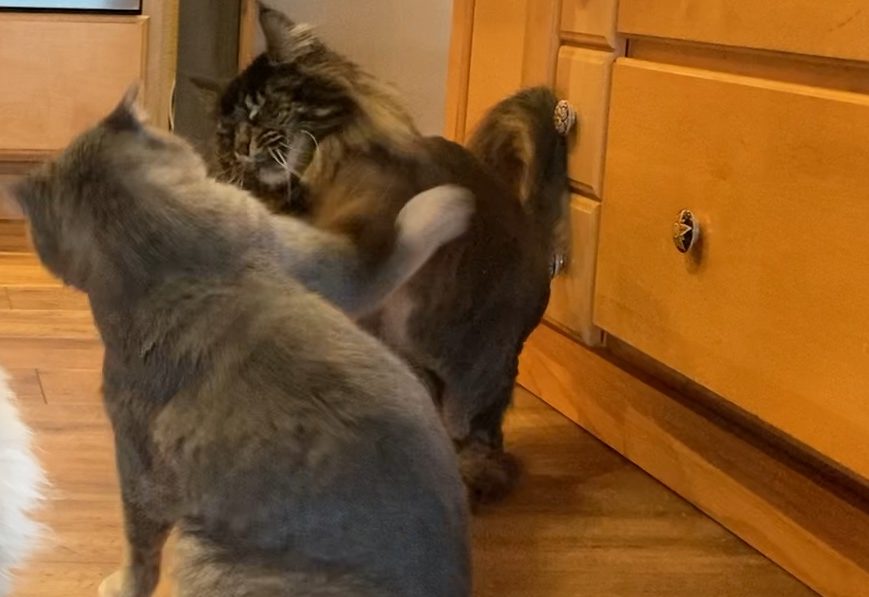 It is not uncommon for cats in a multi-cat household to engage in some redirected aggression. For example, cats waiting to be fed may engage in “boxing matches”. A cat watching birds at a window may swat at another cat who comes “too close” to her “bird-watching” spot. The cats are frustrated because the food or the birds are not available and they release their frustration through a physical motion. These incidents usually extinguish themselves and there are not lasting consequences.
It is not uncommon for cats in a multi-cat household to engage in some redirected aggression. For example, cats waiting to be fed may engage in “boxing matches”. A cat watching birds at a window may swat at another cat who comes “too close” to her “bird-watching” spot. The cats are frustrated because the food or the birds are not available and they release their frustration through a physical motion. These incidents usually extinguish themselves and there are not lasting consequences.
when redirected aggression in your cat becomes a problem
One cat encounters an outdoor cat at the window, and becomes highly aroused, hair standing on end, hissing, growling, howling. He turns on his housemate who is passing by. If the aggressor associates the negative emotional state of a cat fight with his housemate, we may have a bully-victim relationship in the making. The aggressor cat (bully) may become aroused each time he sees the housemate and go after him. The housemate is now the victim and may become fearful of the bully. The bully may guard resources (litter boxes, food) from the victim, making the victim’s life miserable.
When the victim is not another cat
A cat may redirect his frustration and fear on whomever is closest and that could be you or the family dog. Let’s say you drop a ceramic dish, which explodes with a crash and terrifies your cat. You go to pick her up and she hisses and strikes out at you. She may be leery of you after that, slinking away when she spots you, associating you with that horrible noise and things flying through the air.
redirected aggression in your cat – first aid
If the incident involved two cats:
- Place or “herd” the aggressive cat and the victim cat into separate rooms, with litter box, water and the lights off.
- Once the cats are calm, see if there are any injuries and seek veterinary attention if needed.
- If neither cat is injured, see if you can reintroduce them once they seem calm. See if they will eat or play on either side of a closed door. Work up to gradually opening the door – it is not a bad idea to have a barrier such as a baby gate in the doorway.
- This may take anywhere from a few minutes/hours to days/months.
If the victim was the family dog or human, first aid is similar with some modifications. Assess the victim for injuries. A dog will benefit from a quiet room while a human will, most likely, take comfort in discussing the incident with other people. A slow and gradual re-introduction with the cat is still a good idea.
How do I tell if my cat is calm?

- Is his body language calm – ears up, eyes open, muzzle relaxed, whiskers relaxed – not pinned against the muzzle?
- Will she approach you in a friendly way – say, with tail up, relaxed posture ?
- Will he eat a snack?
- Will she play with toys?
redirected aggression in your cat – the aftermath
- Try to identify the trigger.
- If you can identify a possible cause, for example, a neighborhood cat at the window, be proactive and move to prevent future occurrences.
- Coax the cat back to the place where the aggression happened. Allow her to thoroughly examine the area while providing a tasty snack and possibly some toys to make a positive association with the area.
- If the incident involved a person, desensitize the cat to the area where the incident happened before having that particular person return to the area. Once the cat is calm, have the “victim” come back but approach the area gradually. If the cat remains calm, he can come a little closer. The “final” approach should allow the cat to choose if she wants to interact. Have some tasty treats on hand. Use of a harness and leash can be useful in this situation.
- If the incident involved two cats, let each cat return separately and make a positive association with the area. When both of them are calm in the area, you can try having them there together after reintroduction – be prepared in case hostilities break out again.
If the victim continues to trigger aggression in the “bully” cat, consult your veterinarian regarding medication and/or referral to a veterinary behaviorist.
Want to keep up with the world of cats? Subscribe to The Feline Purrspective!

 You are sitting by the window, engrossed in your latest murder mystery. You don’t notice that neighborhood tabby outside your window but your cat does and goes into full battle mode, hissing and striking at the window. You look up and jump, as your cat turns and strikes out at you. She looks like a miniature saber tooth tiger! Alarmed, you throw your glass of water at her as you beat a hasty retreat.
You are sitting by the window, engrossed in your latest murder mystery. You don’t notice that neighborhood tabby outside your window but your cat does and goes into full battle mode, hissing and striking at the window. You look up and jump, as your cat turns and strikes out at you. She looks like a miniature saber tooth tiger! Alarmed, you throw your glass of water at her as you beat a hasty retreat.


